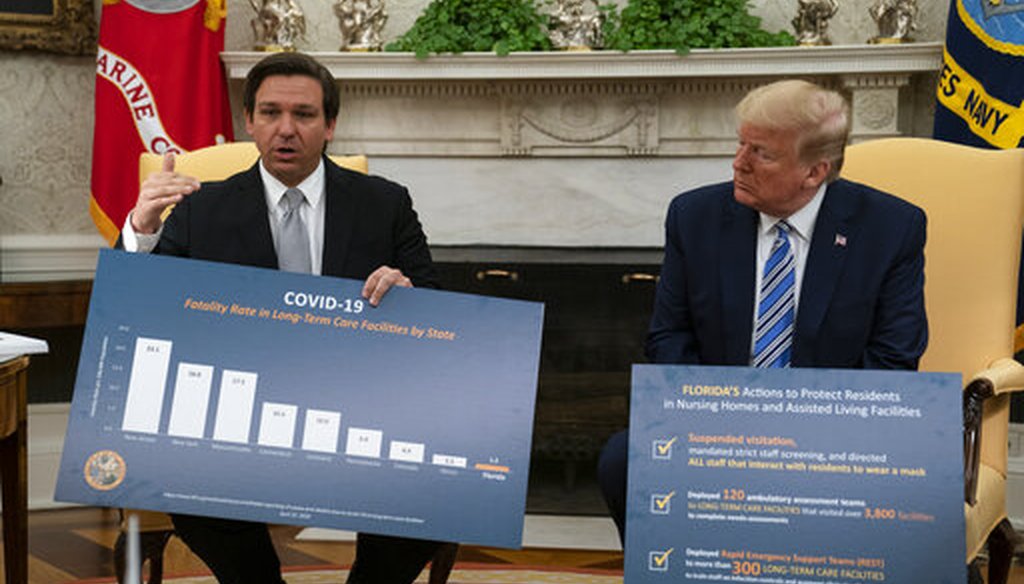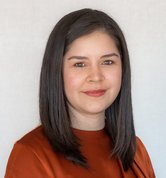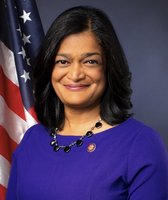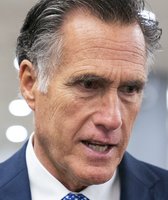Stand up for the facts!
Our only agenda is to publish the truth so you can be an informed participant in democracy.
We need your help.
I would like to contribute

President Donald Trump listens as Gov. Ron DeSantis, R-Fla., talks about the coronavirus response during a meeting in the Oval Office of the White House, April 28, 2020. (AP/Evan Vucci)
If Your Time is short
-
Florida’s data on COVID-19 cases do not definitively prove whether DeSantis is right or wrong.
-
Many people from New York spend time in Florida during the winter months, so it is possible that some of them traveled to Florida infected with the virus. It’s also possible that the virus was carried into Florida by other travelers even before New York issued its stay-at-home order, and that it spread unnoticed before masks and social distancing were recommended.
-
Once a virus is spreading within the community, it becomes more difficult to determine if a case is travel-related.
In their Oval Office meeting, President Donald Trump told Florida Gov. Ron DeSantis to let him know if banning travel from foreign countries was necessary to contain the coronavirus outbreak in Florida.
DeSantis said so far that wasn’t necessary, because the state’s COVID-19 outbreak was mostly due to domestic travel, particularly from New York.
"If you look at our outbreak, not a lot of it is tied to that (international travel)," DeSantis said April 28. "It’s mostly tied to New York City travel into the three Southern Florida (counties). Because the Orlando situation is worlds different than Palm Beach and Broward and Miami-Dade, but yet they have as much international travel as anybody."
The travel patterns of New Yorkers has been a constant rationale of DeSantis’ response to COVID-19 in Florida.
In late March, DeSantis said many New Yorkers, some likely sick with the virus, flocked to Florida to avoid New York’s stay-at-home order, which became effective March 22. The Tampa Bay Times reviewed flight data and did not find any major uptick in the number of flights going to Florida from the New York area after New York Gov. Andrew Cuomo announced the order. On March 20, 158 flights from three New York City-area airports arrived to five Florida airports (Miami, Fort Lauderdale, Palm Beach, Orlando and Tampa). A week later, the number of flights declined to 58.
Sign up for PolitiFact texts
After resisting calls to issue a stay-at-home order for Florida, DeSantis ordered one in early April, and again called out New Yorkers for "jeopardizing the health and safety of Floridians."
PolitiFact wondered about DeSantis’ claim linking Florida’s coronavirus cases to New York. We called and emailed the governor’s press office and the state’s health department asking for data that supported DeSantis’ claim. We did not get information. We also tried reaching the three South Florida counties to discuss whether their cases were mostly tied to travel from New York. We did not get an answer.
We interviewed several infectious disease experts who said publicly available state data was insufficient or unclear enough to conclusively support DeSantis’ claim about New York seeding Florida's coronavirus outbreak.
"The data does not show this or any such determination for a fact, nor will it likely ever give a definitive answer to this. This is the nature of observational data — we can describe what we are seeing, possibly run some statistical analyses, but the fact remains that describing what happened in the past will always be to some degree speculative," said Rebecca S.B. Fischer, an assistant professor of epidemiology and biostatistics at Texas A&M University School of Public Health.
Given widespread transmission of the disease in Florida, experts' bigger message was it doesn’t matter at this point what started it; what matters most is reducing the spread.
RELATED: How to get your news during the time of coronavirus
The state publishes daily COVID-19 updates, listing the number of cases and some details for each case. But that data is presented in a way that does not prove whether DeSantis is right or wrong.
For example, case No. 5,867 is a 37-year-old man with a travel-related case. A "travel detail" column lists Florida and New York, suggesting that the man traveled to New York and within Florida. But the report does not specify if the man got sick after traveling to New York or after traveling within Florida. It doesn’t list travel dates, either. Based on the information collected, the man did not have contact with a confirmed case.
The state’s reporting leaves unanswered questions.
It’s not clear whether a case is marked as travel-related because the person reported a travel history, or because an epidemiologist determined that the case was attributed to travel.
Florida’s first two presumptive COVID-19 cases were announced March 1. They were not tied to South Florida — the patients lived in counties in Florida’s west coast, Manatee and Hillsborough. The first person had not traveled to countries with widespread transmission; the second person had traveled to Italy.
People traveling from China and Europe and returning on cruise ships amplified the number of coronavirus cases in the United States in March, said a May 1 report from the U.S. Centers for Disease Control and Prevention. The CDC said 101 people who were on nine separate cruises during Feb. 11- March 5 tested positive for COVID-19 and went back to 18 states, Florida among them.
The available data at this point suggests that transmission has become well established in Florida with travel playing a minimal role, said Jill Roberts, an assistant professor at the University of South Florida, whose specialities include molecular epidemiology and emerging diseases.
As of May 4, Florida had recorded nearly 37,000 confirmed COVID-19 cases; around 930 were marked as non-Florida residents, but the data did not specify where they were from. The travel details for some non-Florida residents listed New York, Florida, other U.S. states, and foreign countries. Many of Florida’s cases, including those of non-Florida residents, say it’s "unknown" whether they are travel related. Overall, fewer than 2,000 cases were reported as due to travel and contact with a confirmed case.
"In Florida, the majority of the cases have an unknown origin, which would suggest widespread localized transmission in some communities, especially the three southern counties," Roberts said.
One in three coronavirus deaths in Florida have been inside the state’s long-term care facilities, and nearly half of the deaths in elder-care facilities were in South Florida, according to local news reports.
Many people from New York spend time in South Florida during the winter months, so it is possible that some of them traveled to the state with an infection. It’s also possible that the virus was carried into Florida by other travelers.
Once a virus is spreading within the community, it becomes more difficult to determine its source.
There are a number of factors that undermine thorough contact tracing: a person can’t be found for an interview, might be intubated or deceased, reluctant to share information, might not remember, or be untruthful. Family members can serve as a proxy but might have incorrect or insufficient information. It can also be challenging to get information from people diagnosed with a new disease if they feel stigmatized.
Not to mention, Florida has 2.3 contact tracers per 100,000 residents, the Sun Sentinel reported. (A national estimate said states should have 30 per 100,000 residents during a pandemic.)
"Epidemiology is most certainly a science, but not every element from every person’s unique story is going to be reflected in the data," Fischer said.
Our Sources
WhiteHouse.gov, Remarks by President Trump in Meeting with Governor DeSantis of Florida, April 28, 2020
South Florida Sun Sentinel, Florida finally releases details of deaths at individual elder-care centers, May 2, 2020; Florida starts to reopen despite missing a critical tool, May 1, 2020
Florida Gov. Ron DeSantis website, executive orders; executive order 20-91; New Yorkers visiting Florida must self-quarantine for two weeks, governor orders, March 24, 2020
Floridadisaster.gov, Coronavirus: summary of persons being monitored, persons under investigation, and cases, data verified as of April 28, 2020 at 10 a.m.; Coronavirus: summary of persons being monitored, persons under investigation, and cases, data verified as of May 4, 2020 at 10 a.m.
CDC.gov, Public Health Response to the Initiation and Spread of Pandemic COVID-19 in the United States, February 24–April 21, 2020, report issued May 1, 2020
Florida Department of Health, Department of Health Announces Two Presumptive Positive COVID-19 Cases in Florida, March 1, 2020
McClatchyDC.com, After refusing for weeks, Florida releases nursing home records, showing flurry of deaths, May 1, 2020, updated May 2, 2020
Email interview, Rebecca S.B. Fischer, an assistant professor of epidemiology and biostatistics at Texas A&M University School of Public Health, May 3, 2020
Email interview, Jill Roberts, an assistant professor at the University of South Florida, whose specialities include molecular epidemiology and emerging diseases, May 1, 2020
Email interview, George W. Rutherford, epidemiology professor at the University of California, San Francisco, May 1, 2020
Phone interview, Mary Jo Trepka, an infectious disease epidemiologist at Florida International University, May 1, 2020
Contact tracing estimate by the National Association of County and City Health Officials, April 16, 2020


































